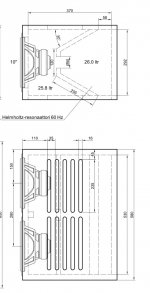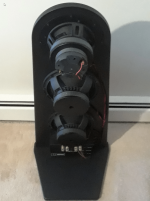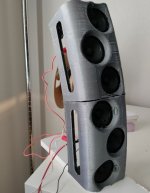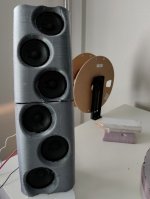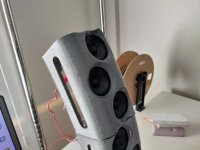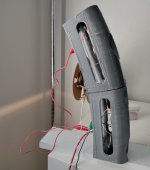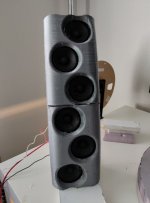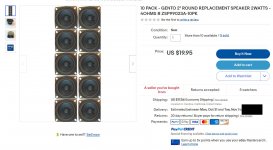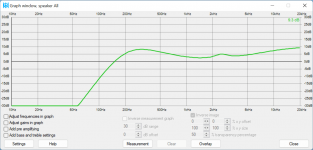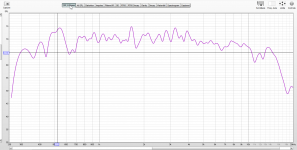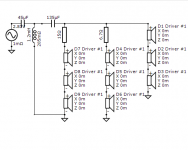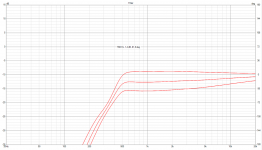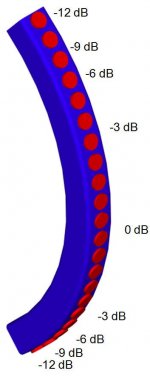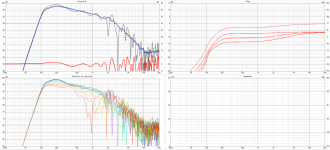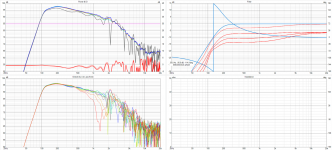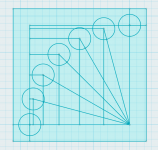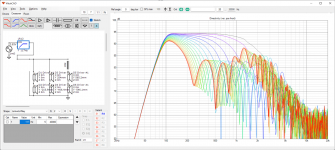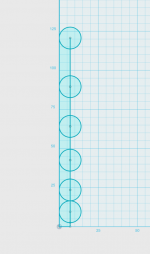Why not change the room acoustics? Such a high room screams for a complete acoustic ceiling cause you don't see it at normal circumstances.
Nice benefit - it transforms the feeling of your room from garage/church to cosy living room 😉
Nice benefit - it transforms the feeling of your room from garage/church to cosy living room 😉
honesty, as much as i hate dsp, a room like this would probably benefit from it
if you want to even have a chance to have flat bass in-room response, id highly consider either a bass line arays, or distributed sub system xo'd at 100hz
but i think your original idea, to build a true cardioid enclosure would be the best solution by far.
Ill be trying my own cardioid bass cabinet, about 150L. id love to see you have a try first
if you want to even have a chance to have flat bass in-room response, id highly consider either a bass line arays, or distributed sub system xo'd at 100hz
but i think your original idea, to build a true cardioid enclosure would be the best solution by far.
Ill be trying my own cardioid bass cabinet, about 150L. id love to see you have a try first
Based on my experiments with cardioid boxes, they really seem to excel in small volumes. Basically use a driver that's 4X as big as you normally would, in an enclosure that's very small.
Similar to Emerald Physics, but Cardioid
Similar to Emerald Physics, but Cardioid
Attachments
interestingBased on my experiments with cardioid boxes, they really seem to excel in small volumes. Basically use a driver that's 4X as big as you normally would, in an enclosure that's very small.
Similar to Emerald Physics, but Cardioid
did you try in a big cab?
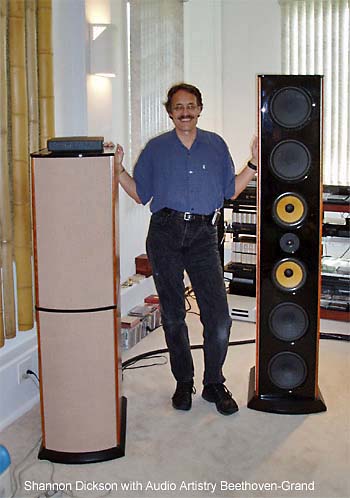
Early dipoles, from the 1990s, used a large baffle
As time's marched on, minimum baffles proved to perform better
Cardioids are basically in a grey zone between "sealed" and "dipole" and because of this, they work better with a small box.
Cardioids depend on the rear wave canceling out the front wave. So the small the baffle is, the higher you can cross it over.
If you're working on a cardioid subwoofer, I can see why you might use a large baffle (80Hz is 4.25 meters long)
But if you're making a cardioid woofer or midrange, you probably want a small baffle. You can simulate all of this in Hornresp.
Exactly, one gets most SPL capability with smallest baffle, although intuition is reverse. Usually people put big baffles to extend low frequency capability of open baffle speakers, which is fine but it robs the SPL capability.
Open baffle speakers have quite bad interference past ~1wl of the driver called "dipole null", which is about the same as diffraction ripple with monopole speakers but worse. Anyway, its function of baffle size, the bigger the baffle the lower in frequency this is and it practically defines upper end of usable bandwidth. One have to low pass the driver to smaller one if one wants good response out from the system. Baffle dimensions define upper limit for usable bandwidth for a driver.
Here is exaggerated thought experiment. Take some small driver like 10" for OB bass and put it on 32" baffle in order to get some low end from the driver. Cool, we've extended the low end but at the same time brought the upper end dipole null / diffraction down in frequency and what we achieved is the same usable bandwidth of few octaves and brought it down in frequency. The problem is we only have a 10" driver on it which can't do much SPL on low frequency open baffle, the lower the bandwidth it does the less SPL capability there is as the volume displacement stays the same while requirement for it goes up dramatically. Instead, if we replaced the small 10" with 32" driver, or 18", we'd get about the same usable bandwidth out from it but now we have gobs of more volume displacement available due to bigger cone area, more SPL capability before poo sound.
OB system has greatest SPL capability when minimal/no baffle is used, just add enough ways and cone area to get the bass extension.
Open baffle speakers have quite bad interference past ~1wl of the driver called "dipole null", which is about the same as diffraction ripple with monopole speakers but worse. Anyway, its function of baffle size, the bigger the baffle the lower in frequency this is and it practically defines upper end of usable bandwidth. One have to low pass the driver to smaller one if one wants good response out from the system. Baffle dimensions define upper limit for usable bandwidth for a driver.
Here is exaggerated thought experiment. Take some small driver like 10" for OB bass and put it on 32" baffle in order to get some low end from the driver. Cool, we've extended the low end but at the same time brought the upper end dipole null / diffraction down in frequency and what we achieved is the same usable bandwidth of few octaves and brought it down in frequency. The problem is we only have a 10" driver on it which can't do much SPL on low frequency open baffle, the lower the bandwidth it does the less SPL capability there is as the volume displacement stays the same while requirement for it goes up dramatically. Instead, if we replaced the small 10" with 32" driver, or 18", we'd get about the same usable bandwidth out from it but now we have gobs of more volume displacement available due to bigger cone area, more SPL capability before poo sound.
OB system has greatest SPL capability when minimal/no baffle is used, just add enough ways and cone area to get the bass extension.
Last edited:
Greatest thing with passive cardioid (mids) is the smallness as you state, the outer dimensions can be small while the internal dimensions are practically big, exactly what one wants for low acoustic interference with easy construction and no box effects and sounds. Front wave cancels the back wave and vice versa, we get pattern control and no box sound. Actually I think the no box sound with very easy construction is the greatest benefit and pattern control is just nice bonus 😀 8" driver fits into 8" x 8" x 4" box which defines the usable upper bandwidth just like with OB, below diffraction. All this is almost free, price is bass but if it is midrange use case we don't need the bass anyway, just use another driver for that.
There is probably use case for cardioid bass as well, but I haven't thought those too much so no opinion. Obviously, the bass is traded off for the pattern / small box size so, which ever works for the application. There certainly is case for bass speaker to have bass 🙂 For midrange bass is not needed and can be traded of for the pattern / small size. Just be sure to take advantage of the bonuses in system level. If there is no need for small size then easiest would be to use big transducer or waveguide instead to get even tighter pattern and retain the bass capability.
There is probably use case for cardioid bass as well, but I haven't thought those too much so no opinion. Obviously, the bass is traded off for the pattern / small box size so, which ever works for the application. There certainly is case for bass speaker to have bass 🙂 For midrange bass is not needed and can be traded of for the pattern / small size. Just be sure to take advantage of the bonuses in system level. If there is no need for small size then easiest would be to use big transducer or waveguide instead to get even tighter pattern and retain the bass capability.
Last edited:
Since I'm generally not a big fan of arrays, I decided to build something extremely cheap.
Basically I didn't want to invest $400 in parts, only to find it sounds bad.
Here's what I came up with.
Basically I didn't want to invest $400 in parts, only to find it sounds bad.
Here's what I came up with.
Attachments
The cost of these is hilariously low.
Drivers are two bucks each. (Same midrange as Bill Waslo's Cosyne horns)
You can get them from eBay
Each segment of the arc has three woofers
The cost of the filament for each segment is five bucks
So you could make a six driver array for $22
Drivers are two bucks each. (Same midrange as Bill Waslo's Cosyne horns)
You can get them from eBay
Each segment of the arc has three woofers
The cost of the filament for each segment is five bucks
So you could make a six driver array for $22
Attachments
Here's how the frequency response looks with a fairly wonky network.
Basically the lowest driver in the array is getting full power, the two above it are wired in series with each other, and the three above it are wired in series with each other.
And then the three sets described above are wired in parallel.
The response is much better than I expected.
This measurement was done under the crudest of circumstances, I just set the mic up on the desk of my office with the speakers set on top of my 3D printer about two meters away AND quite close to a corner. Far from ideal.
Basically the lowest driver in the array is getting full power, the two above it are wired in series with each other, and the three above it are wired in series with each other.
And then the three sets described above are wired in parallel.
The response is much better than I expected.
This measurement was done under the crudest of circumstances, I just set the mic up on the desk of my office with the speakers set on top of my 3D printer about two meters away AND quite close to a corner. Far from ideal.
Attachments
This isn't the final crossover, but gives you a general idea.
Basically the resistors are used to power taper things to achieve something comparable to Keele's CBT shading and the crossover in front of the array is there so that I can cross the array over to a woofer.
Basically the resistors are used to power taper things to achieve something comparable to Keele's CBT shading and the crossover in front of the array is there so that I can cross the array over to a woofer.
Attachments
I've been messing around with CBT-like arrays for the past couple of weeks. I've come to two conclusions:
1) The high frequencies are pretty rough with these things. With a lot of EQ, you can get them to play up to about 15khz, but you have to boost the high frequencies A LOT, and this exacerbates the fact that the treble is already kinda rought, because we're basically trying to get a single driver to play from 80Hz to 20Khz. Trying to coax eight octaves of bandwidth out of a driver is tough, even if you have a bunch of them. Adding more drivers improves the efficiency and the low frequency output, but makes the highs sounds ragged. Using a limited number of drivers improves how things sound at high frequency, but reduces the efficiency and dynamics of the array, overall.
2) I like the concept of the CBT, but I think it might works better if it was a two-way or a three way.
1) The high frequencies are pretty rough with these things. With a lot of EQ, you can get them to play up to about 15khz, but you have to boost the high frequencies A LOT, and this exacerbates the fact that the treble is already kinda rought, because we're basically trying to get a single driver to play from 80Hz to 20Khz. Trying to coax eight octaves of bandwidth out of a driver is tough, even if you have a bunch of them. Adding more drivers improves the efficiency and the low frequency output, but makes the highs sounds ragged. Using a limited number of drivers improves how things sound at high frequency, but reduces the efficiency and dynamics of the array, overall.
2) I like the concept of the CBT, but I think it might works better if it was a two-way or a three way.
Based on the comments in post #54, I tried make something CBT-ish, but only for low and midbass frequencies.
The idea that I had, was something comparable to a "sub / satellite" system, where directivity above about 700Hz would be controlled by a waveguide, and directivity below 350Hz would be controlled by the shape of the array.
I found something that I think is kind of interesting. Basically the geometry and shading of the array led to a design that's close to omnipolar.
That might sound uneventful, since subs are omnipolar in general, but this particular design measures nearly one meter tall by one meter deep. So one would expect it to be directional above about 340hz. But it's not, for the most part. I think the reason for this is because the geometry is so curved - 90 degrees in total.
So I'm going to take another crack at it, and this time use a narrower arc, perhaps 45 degrees instead.
The third pic below is the exact same array, but measured from the BACK instead of the front. Basically illustrating that the CBT concept widens the beam in FRONT of the speaker and narrows it BEHIND.
The idea that I had, was something comparable to a "sub / satellite" system, where directivity above about 700Hz would be controlled by a waveguide, and directivity below 350Hz would be controlled by the shape of the array.
I found something that I think is kind of interesting. Basically the geometry and shading of the array led to a design that's close to omnipolar.
That might sound uneventful, since subs are omnipolar in general, but this particular design measures nearly one meter tall by one meter deep. So one would expect it to be directional above about 340hz. But it's not, for the most part. I think the reason for this is because the geometry is so curved - 90 degrees in total.
So I'm going to take another crack at it, and this time use a narrower arc, perhaps 45 degrees instead.
The third pic below is the exact same array, but measured from the BACK instead of the front. Basically illustrating that the CBT concept widens the beam in FRONT of the speaker and narrows it BEHIND.
Attachments
I tried narrowing the angle of the array, in order to narrow the beamwidth. Results weren't really great TBH. I think that the shading of the array creates a situation where the beamwidth control collapses at a higher frequency than you would expect.
Basically -
In an array that's not shaded, the beamwidth control extends to about the size of the array. For instance, if you have an array that's two meters tall, and it's unshaded, it will control beamwidth down to about 170Hz. (sound travels at 34,300 centimeters per second.)
With this shaded and curved array (CBT-ish) the beamwidth control only extends to about 350hz or so. Basically, the array would need to be four meters tall to control directivity down to 170Hz.

Here's the response with no lowpass crossover

Here's the response with a 2nd order LR crossover
Basically -
In an array that's not shaded, the beamwidth control extends to about the size of the array. For instance, if you have an array that's two meters tall, and it's unshaded, it will control beamwidth down to about 170Hz. (sound travels at 34,300 centimeters per second.)
With this shaded and curved array (CBT-ish) the beamwidth control only extends to about 350hz or so. Basically, the array would need to be four meters tall to control directivity down to 170Hz.

Here's the response with no lowpass crossover

Here's the response with a 2nd order LR crossover
Here's how things look with a log spaced array. I think this is better. It's much easier to build (because the baffle is flat) and the directivity control works over a wider beamwidth.
The CBT array seems to offer WIDE beamwidth over a wide bandwidth, but what I'm looking for in NARROW beamwidth.
But I think I can improve on this a bit, by curving the array electrically, via the crossover network, similar to JBL's commercial CBT speakers:
https://www.diyaudio.com/community/threads/straight-line-cbt-array.254402/
The CBT array seems to offer WIDE beamwidth over a wide bandwidth, but what I'm looking for in NARROW beamwidth.
But I think I can improve on this a bit, by curving the array electrically, via the crossover network, similar to JBL's commercial CBT speakers:
https://www.diyaudio.com/community/threads/straight-line-cbt-array.254402/
Attachments
Comparison between an unshaded straight array and a frequency shaded straight array. The frequency shading means only the higher frequencies are shaded, the bottom end still has full power on all drivers. I don't know about you, but that's what I would be looking for if I were in your shoes... 🤔

I'd want that vertical beam, to send as little energy as possible to the floor and ceiling...
Hardly any change between these two on the low end, more consistent beam in the shaded array.
I'd want that vertical beam, to send as little energy as possible to the floor and ceiling...
Hardly any change between these two on the low end, more consistent beam in the shaded array.
So for >700Hz - what do you plan? A normal tweeter will not go that low, there are nice Horns for 2" coaxial drivers.
With such a solution I would not build an array but put the Horn in the middle and driver on top and underneath. For e.g. 2x 6-8" next to each other and 4 under and over the Horn. Wit dedicatet frequency range and some space between the drivers you could influence the beahviour of the beam.
Much fun doing good measurements with such a setup ;-)
With such a solution I would not build an array but put the Horn in the middle and driver on top and underneath. For e.g. 2x 6-8" next to each other and 4 under and over the Horn. Wit dedicatet frequency range and some space between the drivers you could influence the beahviour of the beam.
Much fun doing good measurements with such a setup ;-)
Done 😉: https://www.diyaudio.com/community/threads/array-of-micro-speakers-with-shading-in-ath4-horn.391947/So for >700Hz - what do you plan?
- Home
- Loudspeakers
- Multi-Way
- Hybrid Cardioid Speaker
